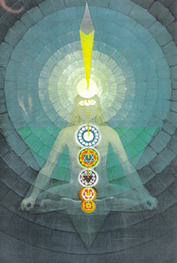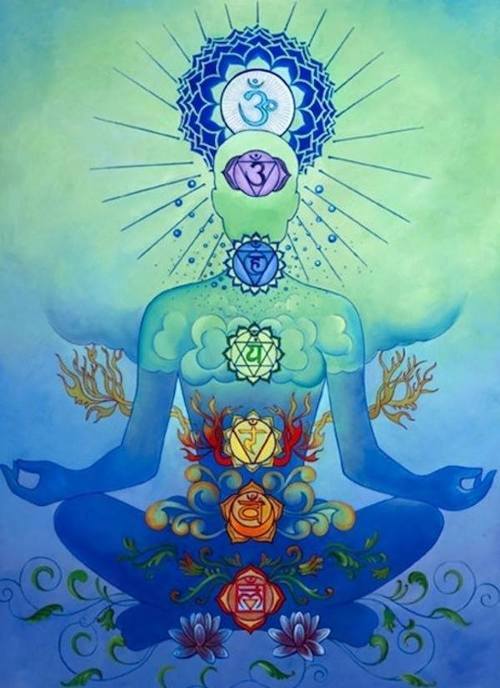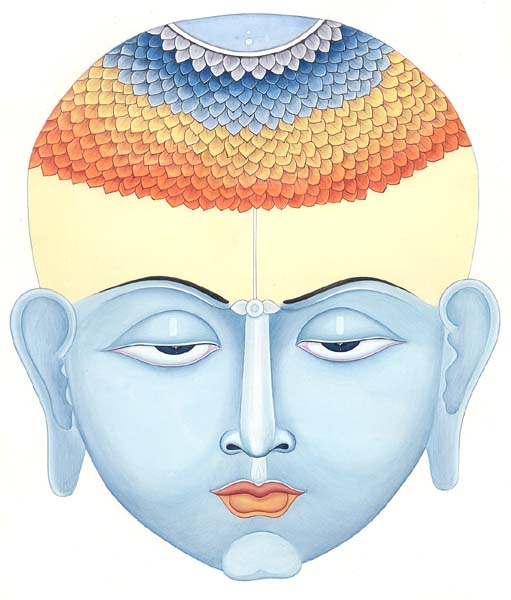THE CHAKRAS
 Within our body are subtle energy channels that can not be seen. These channels correspond with our physical nervous system. It therefore stands to reason that the major subtle channels run along the spine and correspond with the largest nerve in the body – the spinal chord.
Within our body are subtle energy channels that can not be seen. These channels correspond with our physical nervous system. It therefore stands to reason that the major subtle channels run along the spine and correspond with the largest nerve in the body – the spinal chord.
The seven largest energy centres are called chakras and are situated from the base of the spine up to the crown of the head. Each chakra corresponds with an organ of the body and is represented by a color, an animal, a musical note, an element and a symbol.
The chakras are like energy substations, storehouses of energy. The easiest way to explain them is to think about what happens when you switch on a light. You flick the switch and the light bulb shines. You can not see the electricity, however you know that it is there. The electricity is generated by the power station and routed via substations and wires to your house. You cannot see the energy or the chakras in your body but you know they are there or else you would not be alive. Our life force (prana in Sanskrit, chi in Chinese) flows through these subtle energy channels and is stored in the chakras.
|
CHAKRA |
COLOUR |
SYMBOL |
ELEMENT |
MANTRA |
ANIMAL |
SITUATION |
CONTROLS |
RELATES
TO |
|
Muladhara |
Red |
|
Earth |
Lam |
Elephant |
base
of spine |
eliminatory
system |
family
& background |
|
Svadhisthana |
Orange |
|
Water |
Vam |
Aligator |
between
base and navel |
bladder
and reproductive organs |
sexual
energy & money |
|
Manipura |
Yellow |
|
Fire |
Ram |
Ram |
behind
Navel |
digestive
system |
self
esteem & confidence |
|
Anahata |
Green |
|
Air |
Yam |
Antelope |
heart
area |
heart
and lungs |
unconditional
love |
|
Vishudda |
Blue |
|
Ether |
Ham |
Elephant |
throat
area |
larynx
and pharynx |
will
and communication |
|
Ajna |
Indigo |
|
Ether |
Om |
– |
between
eyebrows |
pituitary
gland |
higher
consciousness |
|
Sahasrara |
Violet |
– |
– |
– |
– |
crown
of head |
pineal
gland |
spirituality |
THE DIFFERENT BODIES OR SHEATHS THAT MAKE UP THE HUMAN BEING

Yoga works on the entire human being in a many different ways. Yogis believe that we are made up of five different bodies and these bodies are called sheaths. In Sanskrit they are know as koshas:
- 1. The annamaya or cellular (physical) body is experienced through sensory perception and it is maintained by food. The yoga postures stretch, tone and strengthen this body.
- 2. The pranamaya sheath or the breath body consists of energy or electrical currents and is an exact replica of our physical body, however it is very subtle and is etheric. It is sustained by the breath. The deep breathing exercises in yoga improve this sheath and bring about a great feeling of wellbeing and rejuvenation
- 3. The manomaya sheath or the mental body is experienced through the power of thought and has a profound effect on the state of our well being. Depression, anger, stress and immune system breakdown are registered on this level. The inverted postures stimulate the glandular system to produce hormones and chemicals that enhance our functioning on this level.
- 4. The vijnanamaya sheath or intellectual body is maintained through inspiration. In it resides our discriminatory faculties, our awareness of right and wrong as well as our creative abilities and intuition. This sheath is stimulated by postures that bring about withdrawal of the senses i.e. the Pose of Tranquillity and the Spider.
- 5. The anandamaya kosha or the bliss body is very subtle, is hard to recognise and is difficult to explain. It is the experience of pure well being. The cosmic counterpart to this bliss feeling is the physical orgasm. Yoga puts us on the path to pure well being.
PRANA AND IONISATION

In yoga we work with prana.
When we breathe, eat, drink water or absorb sunlight we absorb the energy from these substances. This is the prana, vital energy, the life force that keeps the human being functioning. In yoga, this vital force is called prana. The Chinese call it ‘chi’. Prana is in the air that we inhale however, it is not the oxygen and it is in the food that we eat, but it is not the carrot. It is the subtle energy that keeps us alive. Through full active breathing and the practise of yoga postures the human being can absorb and store more prana than usual and balance the chakras, and this is what leaves you feeling so alive after a yoga session. The oxygen that we breathe and the food that we eat are converted into energy to keep us alive. As this conversion takes place, toxins are formed and eliminated. These toxins, and the elimination of them, are referred to as apana.
An excellent way of explaining prana is to compare it to electricity. When you turn the bedroom light on the globe shines, proving that the energy is present. You know that the electricity is there but you can not see it. Everything and everyone exerts electromagnetic currents.

 Return to menu
Return to menu